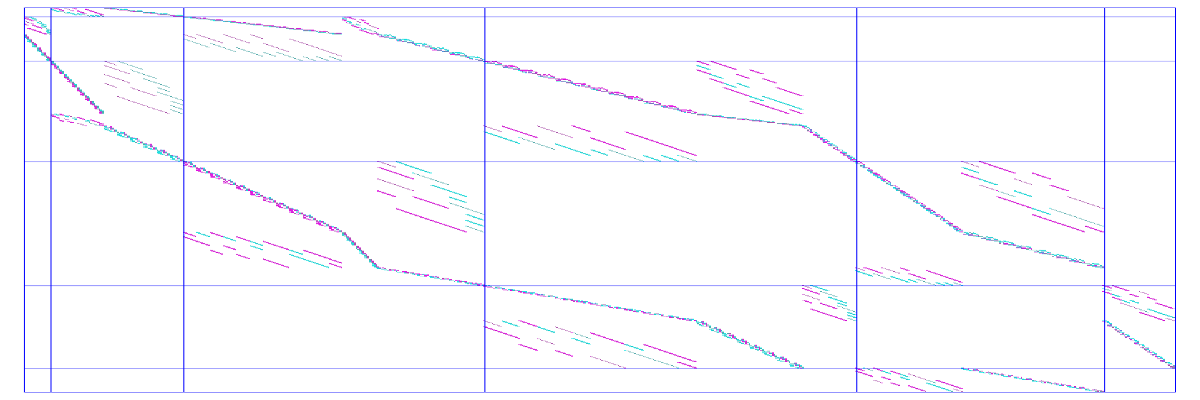Implementing the Dirac operator D for products  of simplicial complexes
of simplicial complexes  without going to the Barycentric refined simplicial complex has numerical advantages. If G is a finite abstract simplicial complex with n elements and H is a finite abstract simplicial complex with m elements, then
without going to the Barycentric refined simplicial complex has numerical advantages. If G is a finite abstract simplicial complex with n elements and H is a finite abstract simplicial complex with m elements, then  is a strong ring element with n*m elements. Its Barycentric refinement is the Whitney complex of the graph in which two elements (a,b) and (c,d) in the product are connected if one is contained in the other. So far, when computing the cohomologies for a product, I always did it with the Barycentric refinement which is a simplicial complex but which is more costly. Working with the Dirac operator of the element G x H in the strong ring is more efficient. It does not matter that the object
is a strong ring element with n*m elements. Its Barycentric refinement is the Whitney complex of the graph in which two elements (a,b) and (c,d) in the product are connected if one is contained in the other. So far, when computing the cohomologies for a product, I always did it with the Barycentric refinement which is a simplicial complex but which is more costly. Working with the Dirac operator of the element G x H in the strong ring is more efficient. It does not matter that the object  was not the Whitney complex of a graph any more, and not even a simplicial complex as the product has thrown us out from the class of simplicial complexes in the larger class of CW complexes (a class no more closed under products so that we had to look at the strong ring which now does things marvelously well). As it an element in the strong ring we have a Dirac operator D on the same Hilbert space as the connection Laplacian L. By Hodge which immediatly generalizes to the strong ring, the Betti numbers are just the dimensions of the kernels of the blocks of the Hodge Laplacian H=D2. Whats the point of computing the Dirac operator of products if we can just know the cohomology for example by Kuenneth? The point is that there is much more to know about the Dirac operator. We are interested in the spectra for example. We are interested in curvatures, we are interested in the nodal regions of the eigenvalues if the complex is a discrete manifold, we are interested in the isospectral deformations by the Lax pair dynamics given naturally on such complexes. In other words, we are not only interested in properties which are homotopy invariant like cohomology or topological invariants like dimension or the structure of singularities, we are also interested in properties which are of metric nature or even differential geometric nature. An example of quantities which are not topological but depend on the metric realization of the geometric object are spectra. Others are the structure of the eigenvectors or the structure of the Euler curvature or then the dynamics of the linear and nonlinear waves on this geometric structure. Then given some functions f, one can also look at the Morse theory but that works the same as before. All basic theorems like Gauss-Bonnet, Poincaré-Hopf or Lefschetz-Brouwer go over to the strong ring. Here are a few examples:
was not the Whitney complex of a graph any more, and not even a simplicial complex as the product has thrown us out from the class of simplicial complexes in the larger class of CW complexes (a class no more closed under products so that we had to look at the strong ring which now does things marvelously well). As it an element in the strong ring we have a Dirac operator D on the same Hilbert space as the connection Laplacian L. By Hodge which immediatly generalizes to the strong ring, the Betti numbers are just the dimensions of the kernels of the blocks of the Hodge Laplacian H=D2. Whats the point of computing the Dirac operator of products if we can just know the cohomology for example by Kuenneth? The point is that there is much more to know about the Dirac operator. We are interested in the spectra for example. We are interested in curvatures, we are interested in the nodal regions of the eigenvalues if the complex is a discrete manifold, we are interested in the isospectral deformations by the Lax pair dynamics given naturally on such complexes. In other words, we are not only interested in properties which are homotopy invariant like cohomology or topological invariants like dimension or the structure of singularities, we are also interested in properties which are of metric nature or even differential geometric nature. An example of quantities which are not topological but depend on the metric realization of the geometric object are spectra. Others are the structure of the eigenvectors or the structure of the Euler curvature or then the dynamics of the linear and nonlinear waves on this geometric structure. Then given some functions f, one can also look at the Morse theory but that works the same as before. All basic theorems like Gauss-Bonnet, Poincaré-Hopf or Lefschetz-Brouwer go over to the strong ring. Here are a few examples:
A four dimensional complex
Lets first take the product of the kite graph G with the house graph H. The f-vector of the Kite graph is (4,5,2), the f-vector of the House graph is (5,6,1). There are 4+5+2=11 simplices in G and 5+6+1=12 simplices in H. The product has 12*11=132 cells so that also the Dirac and connection matrices are 132×132 matrices. Both complexes have maximal dimension 2. The first is contractible, the second is homotopic to a circle. The Betti vector of the 4-dimensional product complex is (1,1,0,0). So, now, to compute the Betti vector, we only need to deal with 132 x 132 matrices. Its Barycentric refinement – the product we have used in the Kunneth paper – would use matrices with several thousand entries.
| The Dirac operator D of Kite x House |
The Hodge Laplacian D2 of Kite x House |
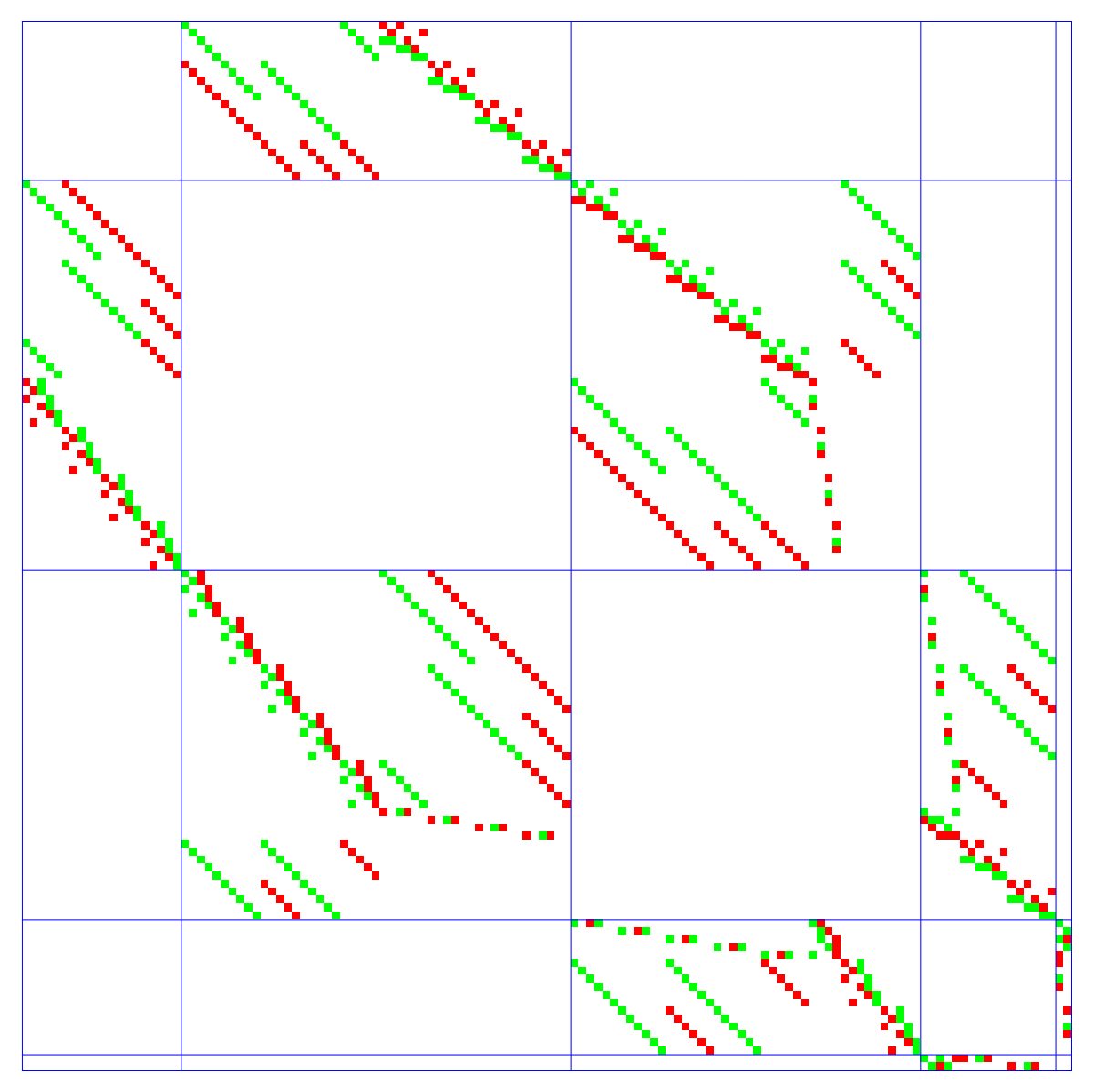
|
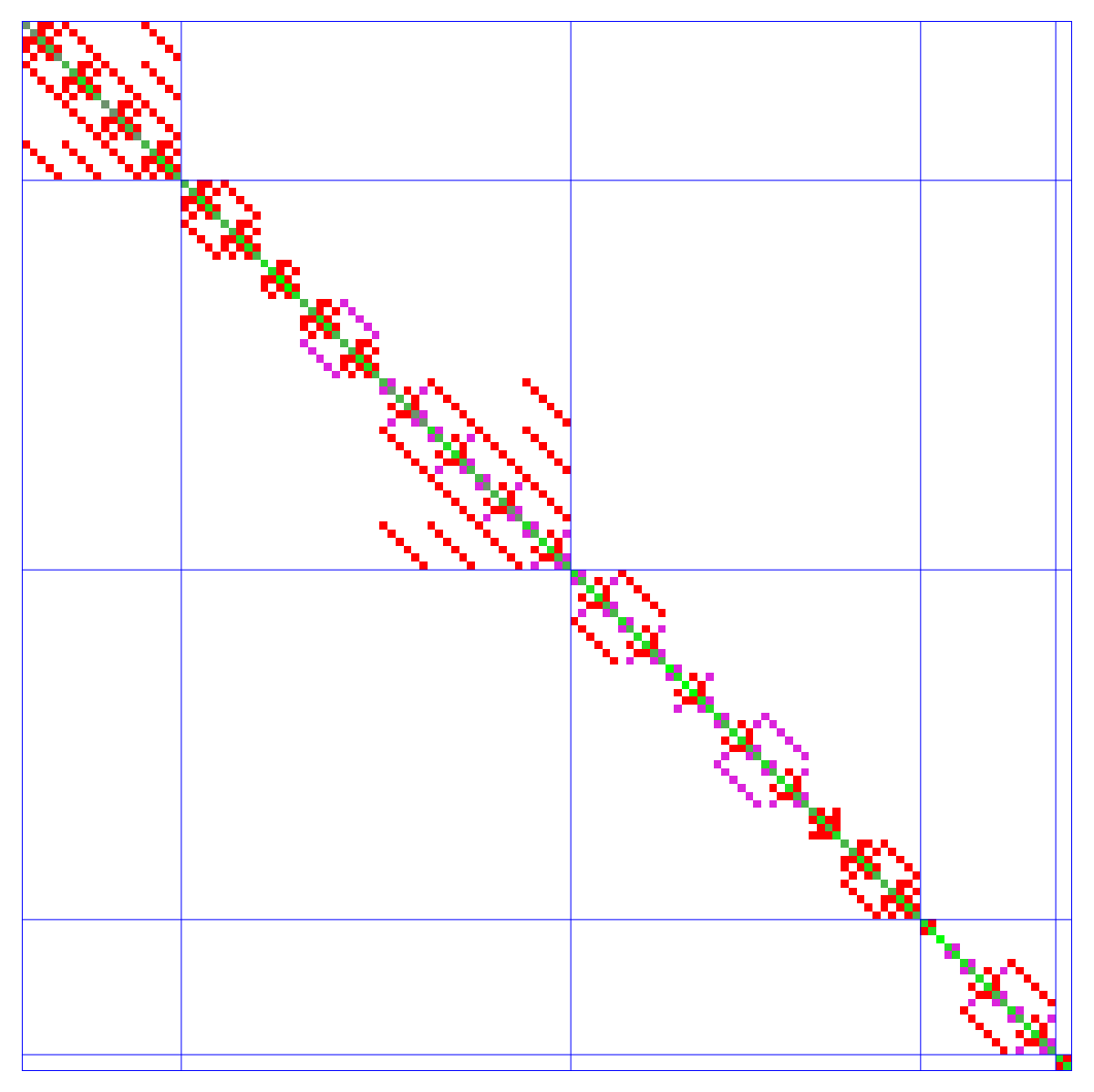 |
| The connection Laplacian of kite x house |
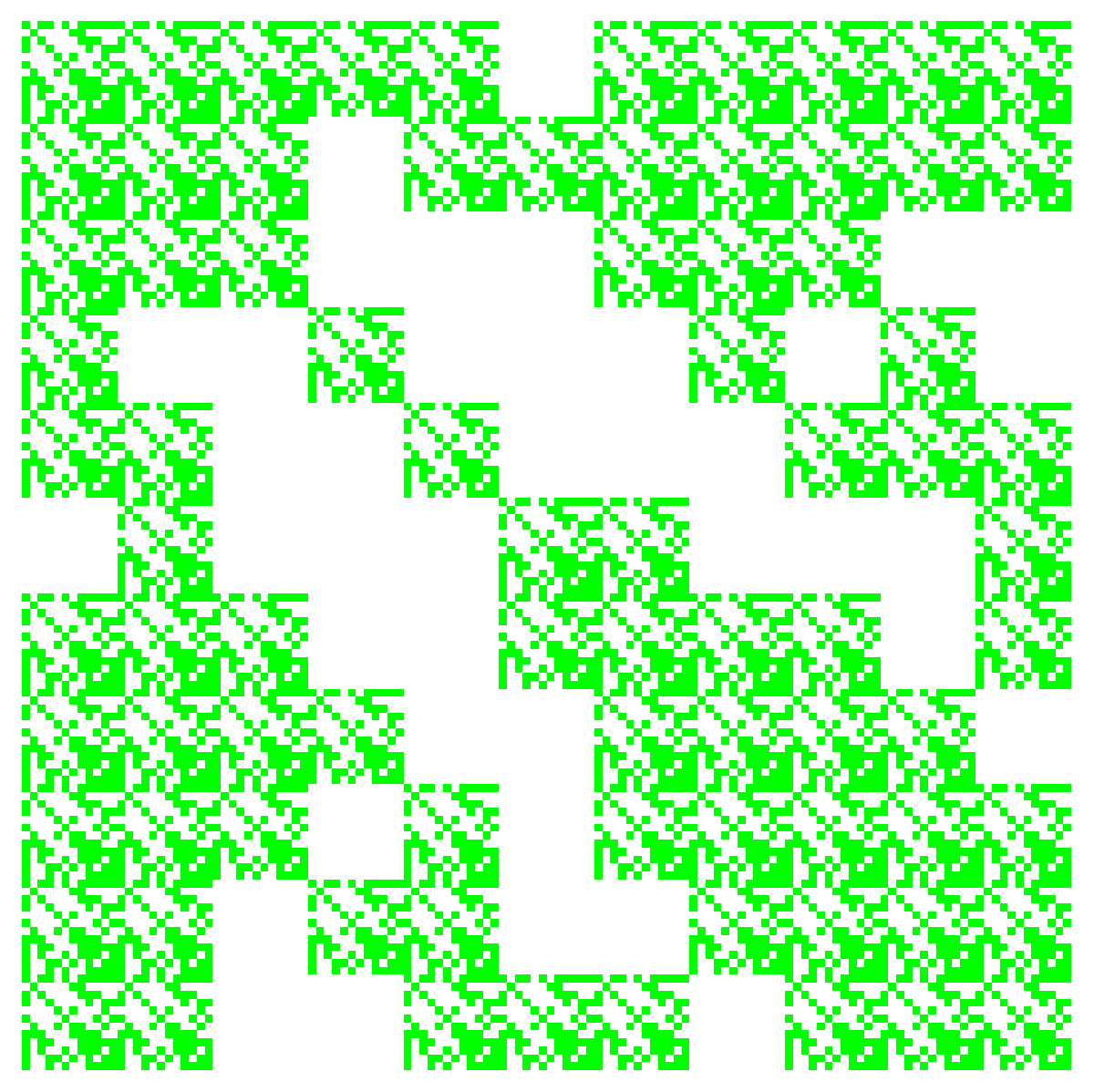
|
The 4-manifold S2 x S2
It is usually quite a hike to compute the simplicial cohomology of the graph product as done here. As done there, we would compute a graph with n*m vertices, then look at its Whitney complex (which has much more elements). The matrices become large. We can do better. For example, lets take the 2-sphere, the octahedron graph with 26 simplices. It has Euler characteristic 2, is the smallest sphere one can build and algebraically given as the Zykov sum of two 0-spheres. The product Dirac operator D is only a 676 x 676 matrix. (In the old way, it would be a MxM matrix, where M is the number of simplices in the product graph). Here we see first D, then the Hodge Laplacian D2. The Hodge Laplacian has 5 blocks for the 0-forms up to the 4-forms (volume forms) of the 4-manifold.
| The Dirac operator D of S2 x S2 |
The Hodge Laplacian D2 of S2 x S2 |
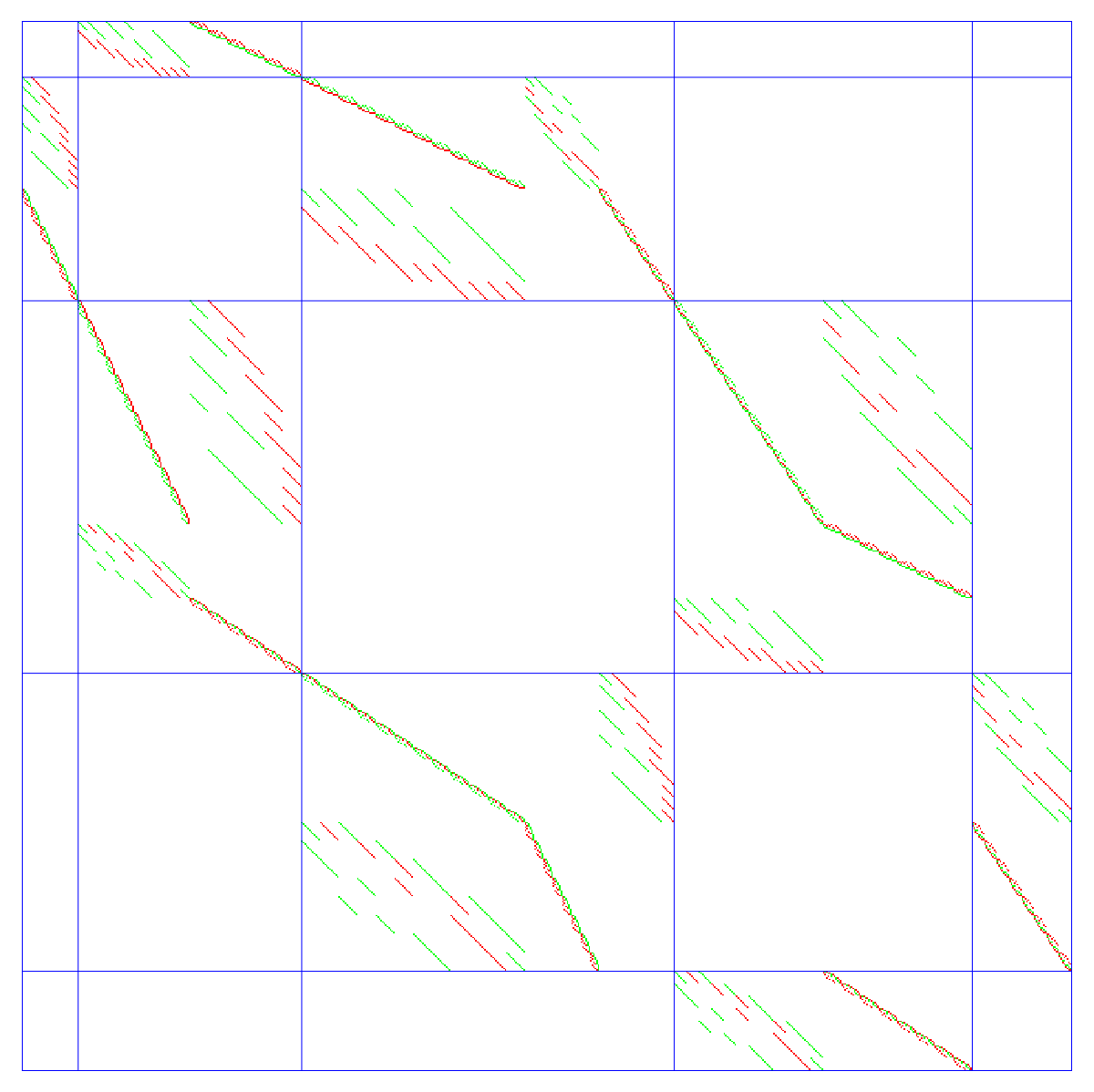
|
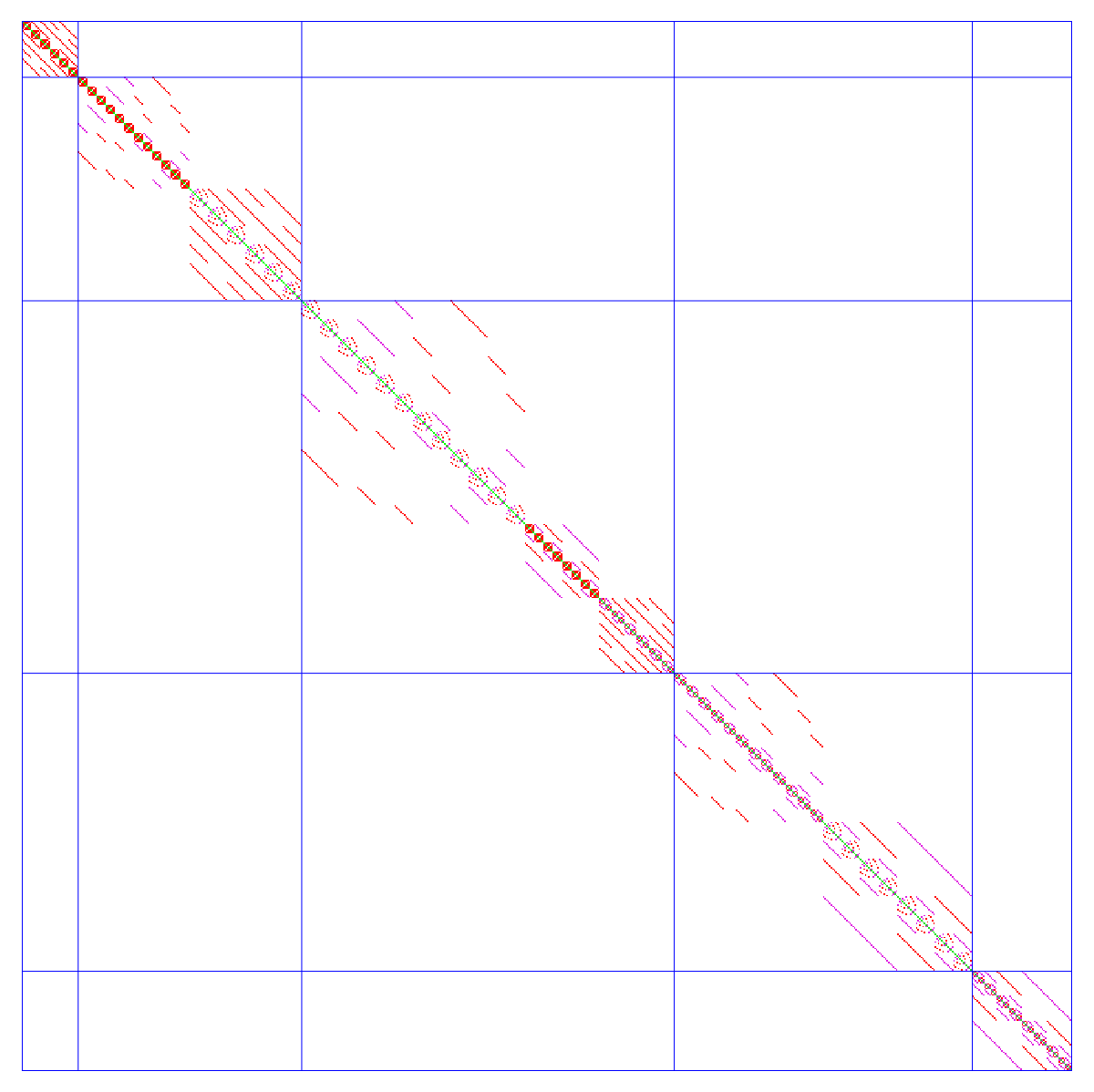 |
As the Poincare Polynomial of the 2-sphere is  , the Poincare Polynomial of the product is
, the Poincare Polynomial of the product is  by Kuenneth. Indeed, we can confirm that the kernels of the blocks of L=D2 have dimension 1,0,2,0,1. By the way, one can easily see algebraically that if the factors G and H satisfy Poincare duality (palindromic Betti vector), then also the product has.
by Kuenneth. Indeed, we can confirm that the kernels of the blocks of L=D2 have dimension 1,0,2,0,1. By the way, one can easily see algebraically that if the factors G and H satisfy Poincare duality (palindromic Betti vector), then also the product has.
So, now lets look at the two 676 x 676 matrices of interest: the Dirac operator D and the connection operator L. Here we see their spectra. The Dirac operator is completely symmetric with respect to positive and negative spectrum. The connection operator has a slight asymmetry. The Dirac operator has a 4 dimensional kernel here (the total sum of the absolute values of the Betti numbers). The connection Laplacian has no kernel by the unimodularity theorem.
| The spectrum of the Dirac operator of S2 x S3 |
The spectrum of the connection operator of S2 x S3 |
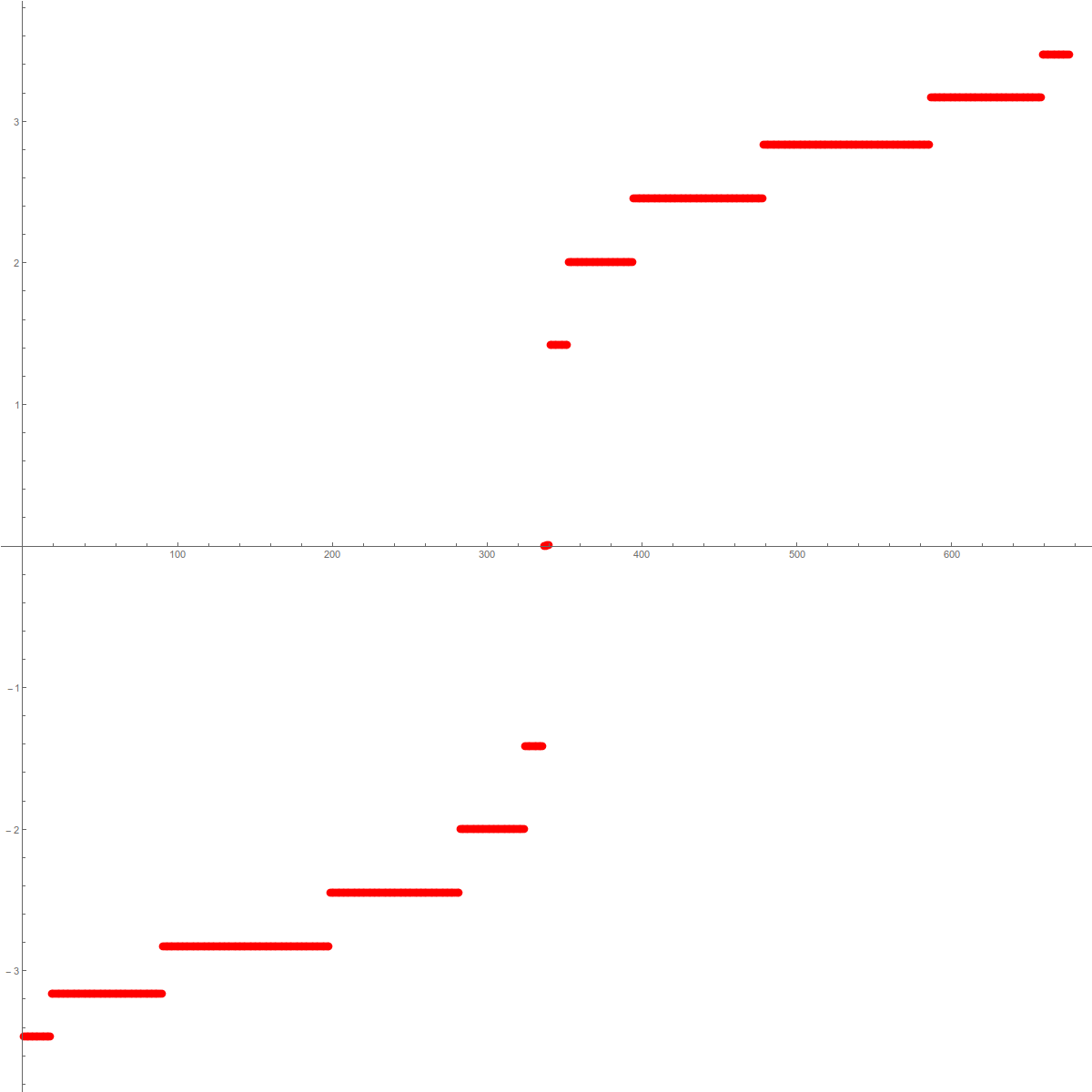
|
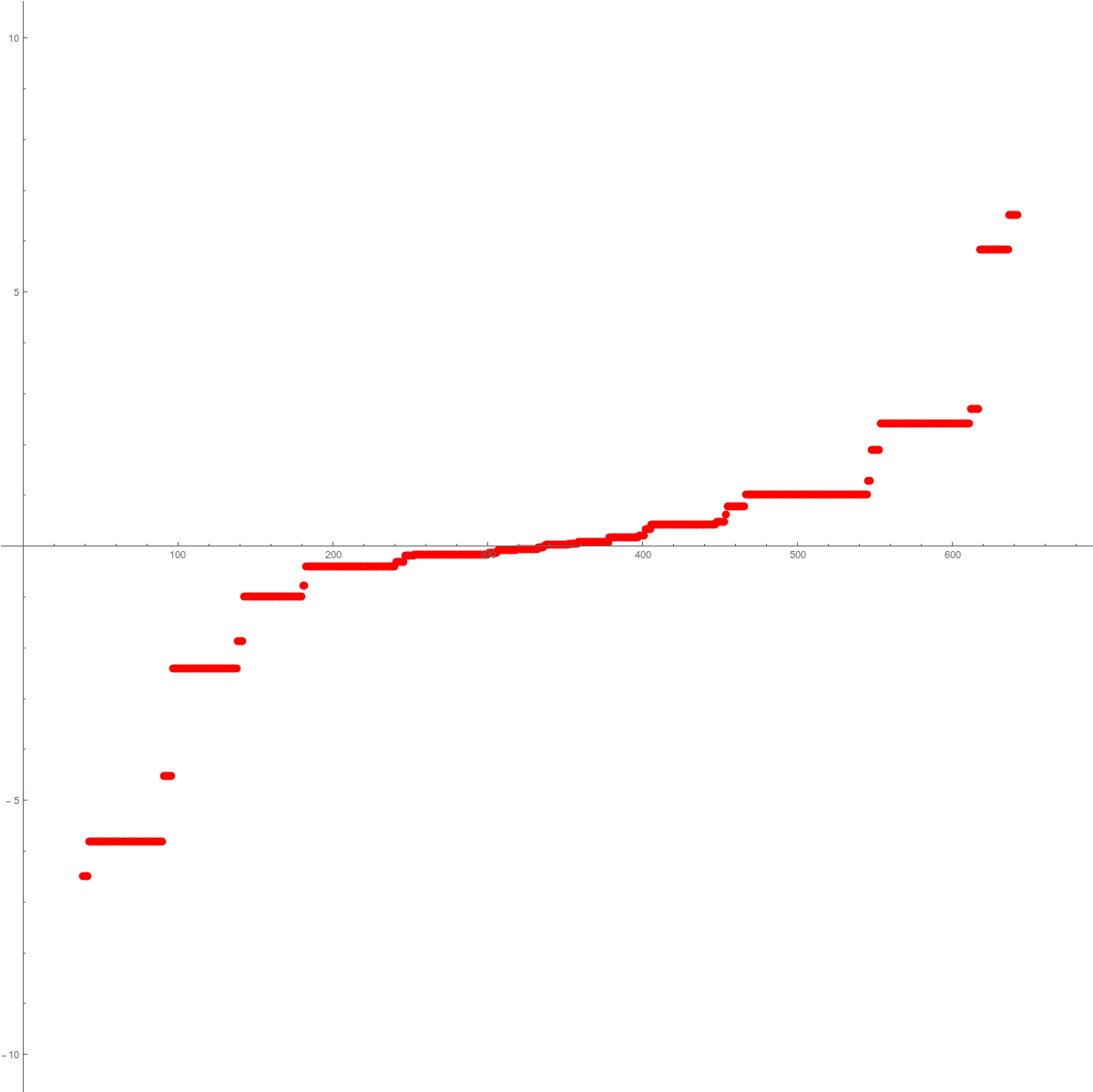
|
The 5-manifold S2 x S3
Now we take for G the 2 sphere and for H the 3 sphere. We get again a simpliy connected manifold. It is a 5 manifold with Betti numbers (1,0,1,1,0,1) and Euler characteristic 0 as any odd dimensional manifold has.
| The Dirac operator of S2 x S3 |
The Hodge Laplacian D2 of S2 x S3 |
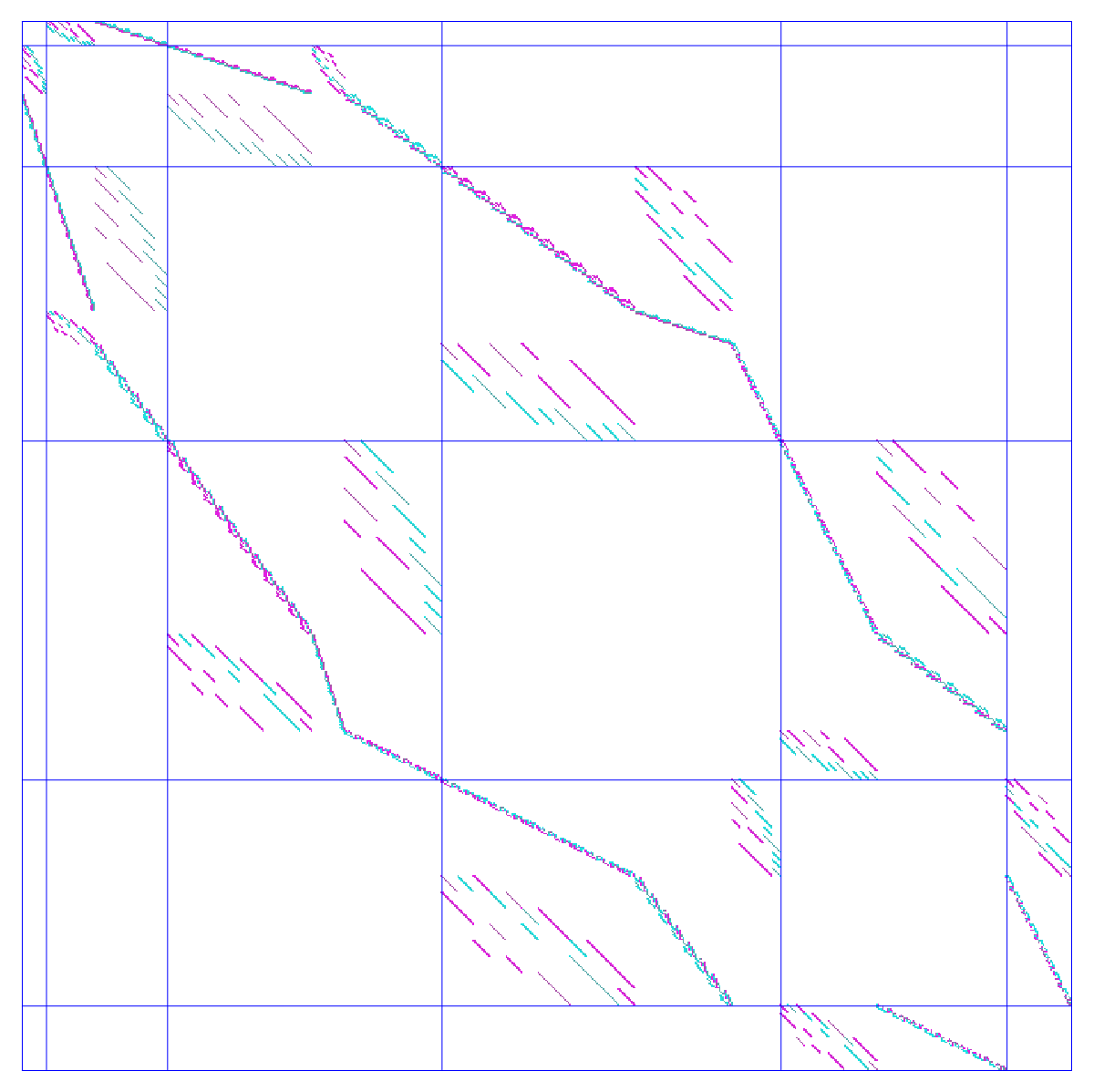
|
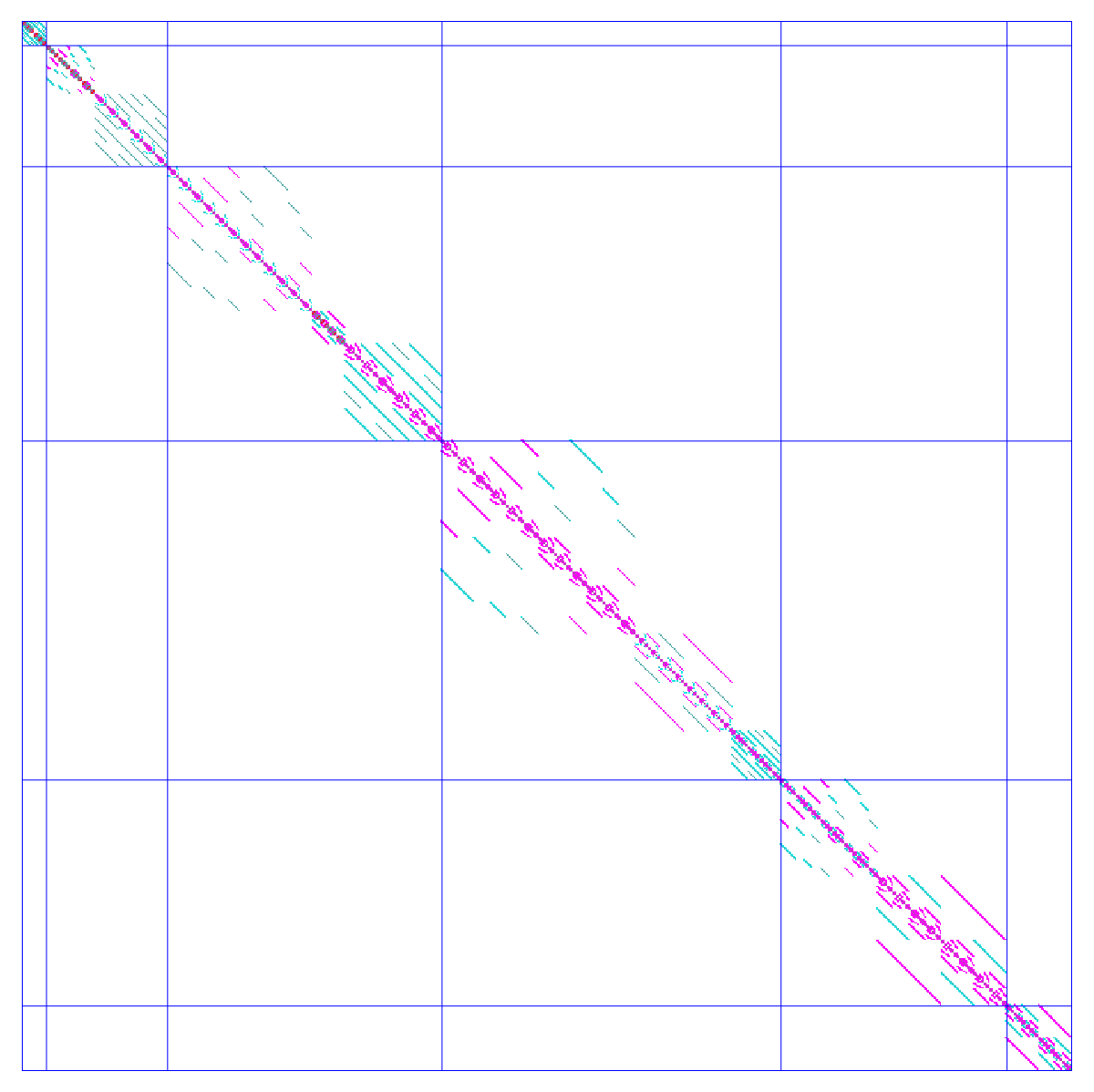 |
Like the Dirac operator which depends on the choice of orientations taken for the simplices of the complex (a choice of basis irrelevant for most things), also the connection Laplacian in the product depends on the order (they are unitarily equivalent) but one is the tensor product of the matrices L(G) with L(H), the other is the tensor product of the matrices L(H) with L(G). The tensor structure by the way immediatly proves that the connection Laplacians of the product are unimodular too. Lets look at these two matrices. You can clearly see the tensor structure:
| The connection Laplacian of S2 x S3 |
The connection operator of S3 x S2 |
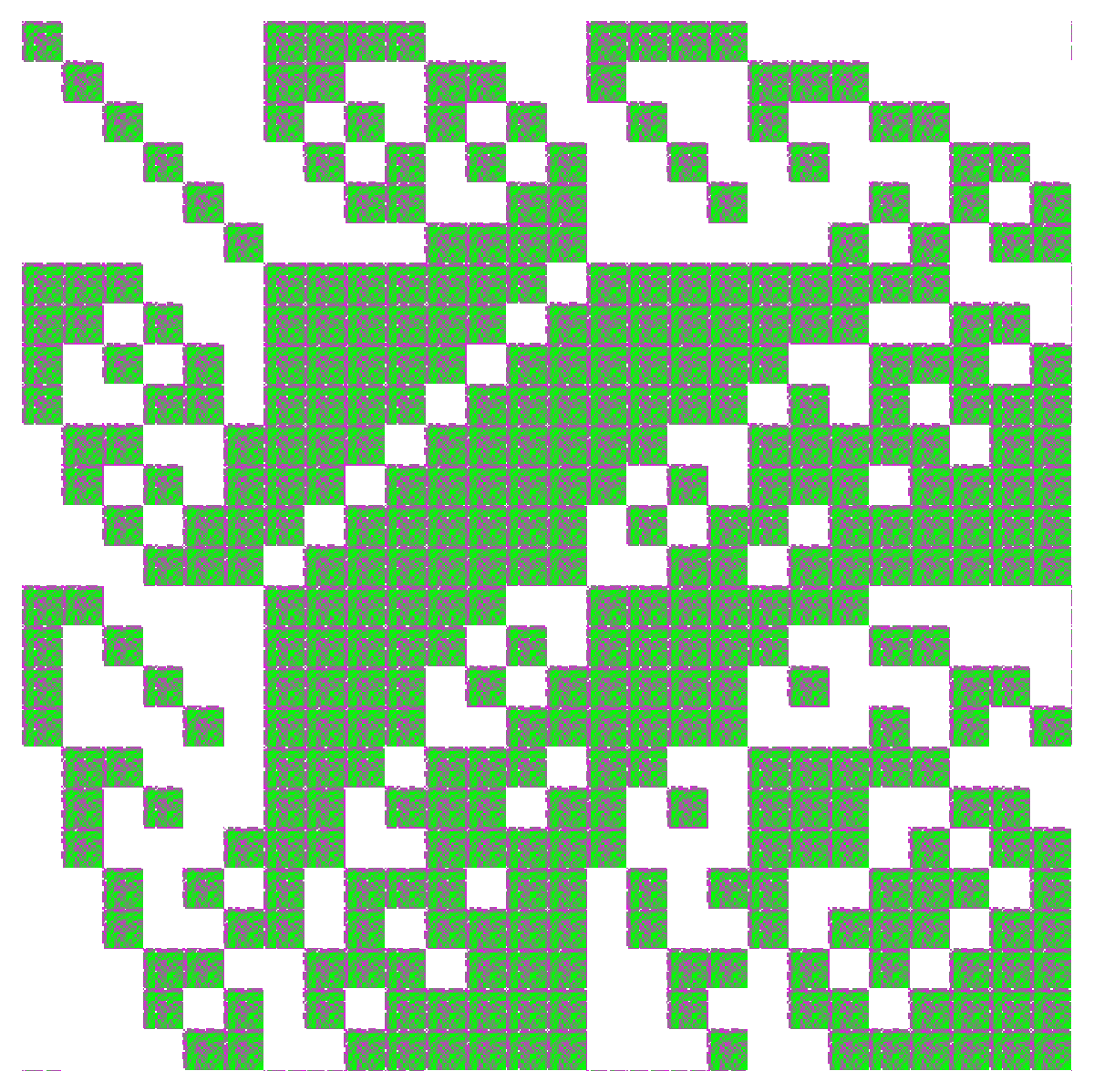
|
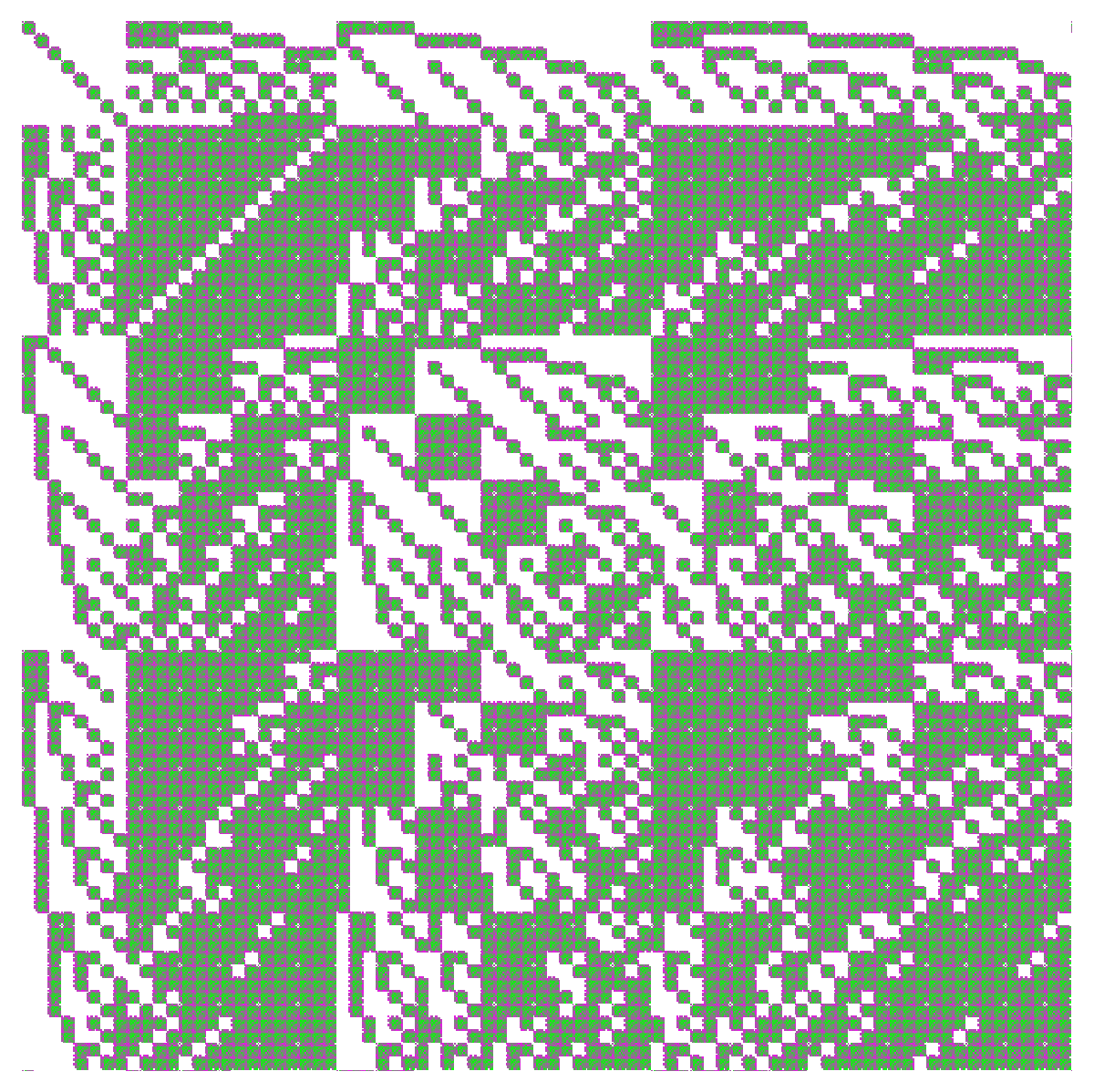
|
The 4-manifold S3 x S1
In this 4 manifold, the Betti vector is (1,1,0,1,1). It is not simply connected.
| The Dirac operator D of S3 x S1 |
The Hodge Laplacian D2 of S3 x S1 |
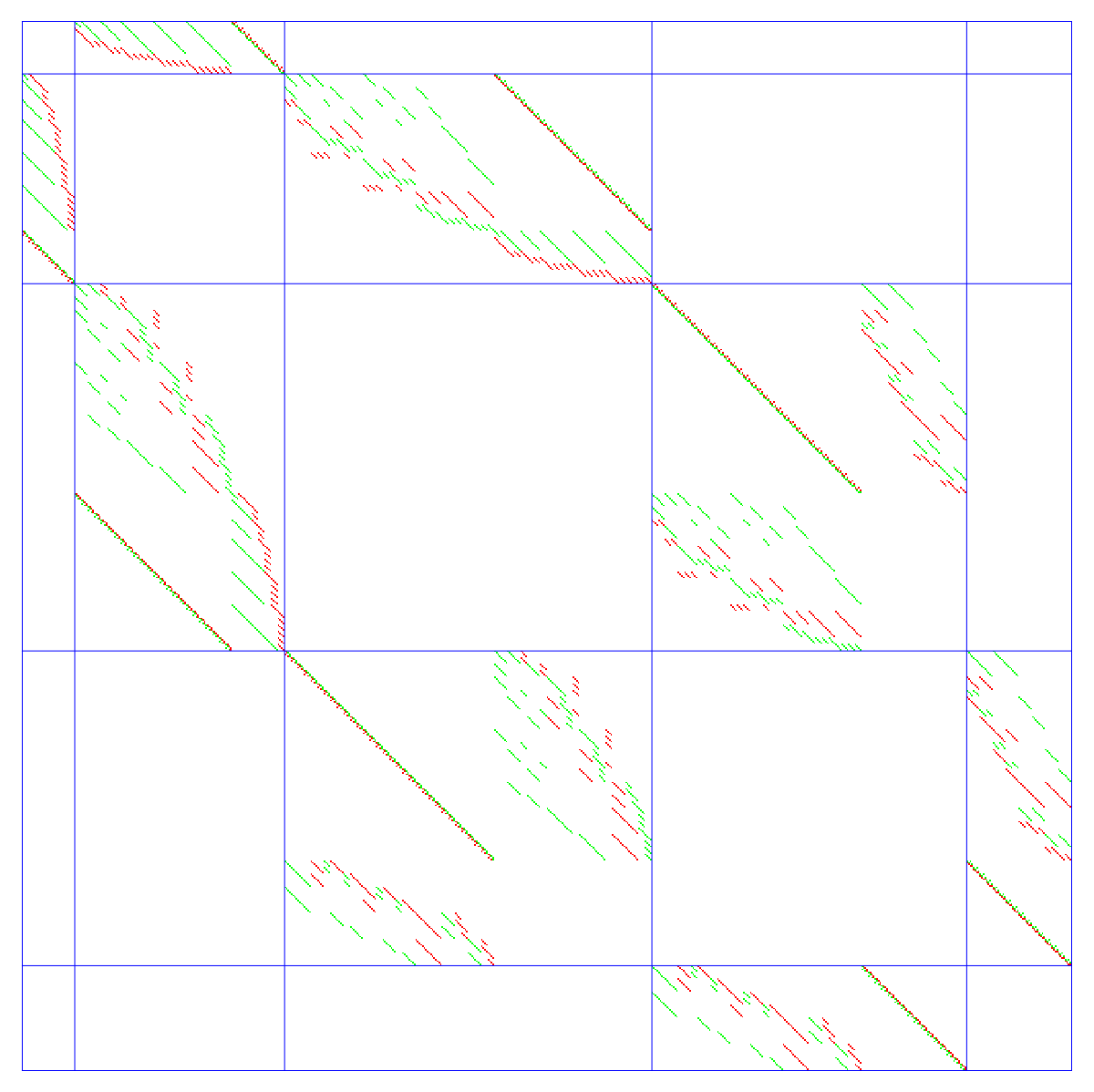
|
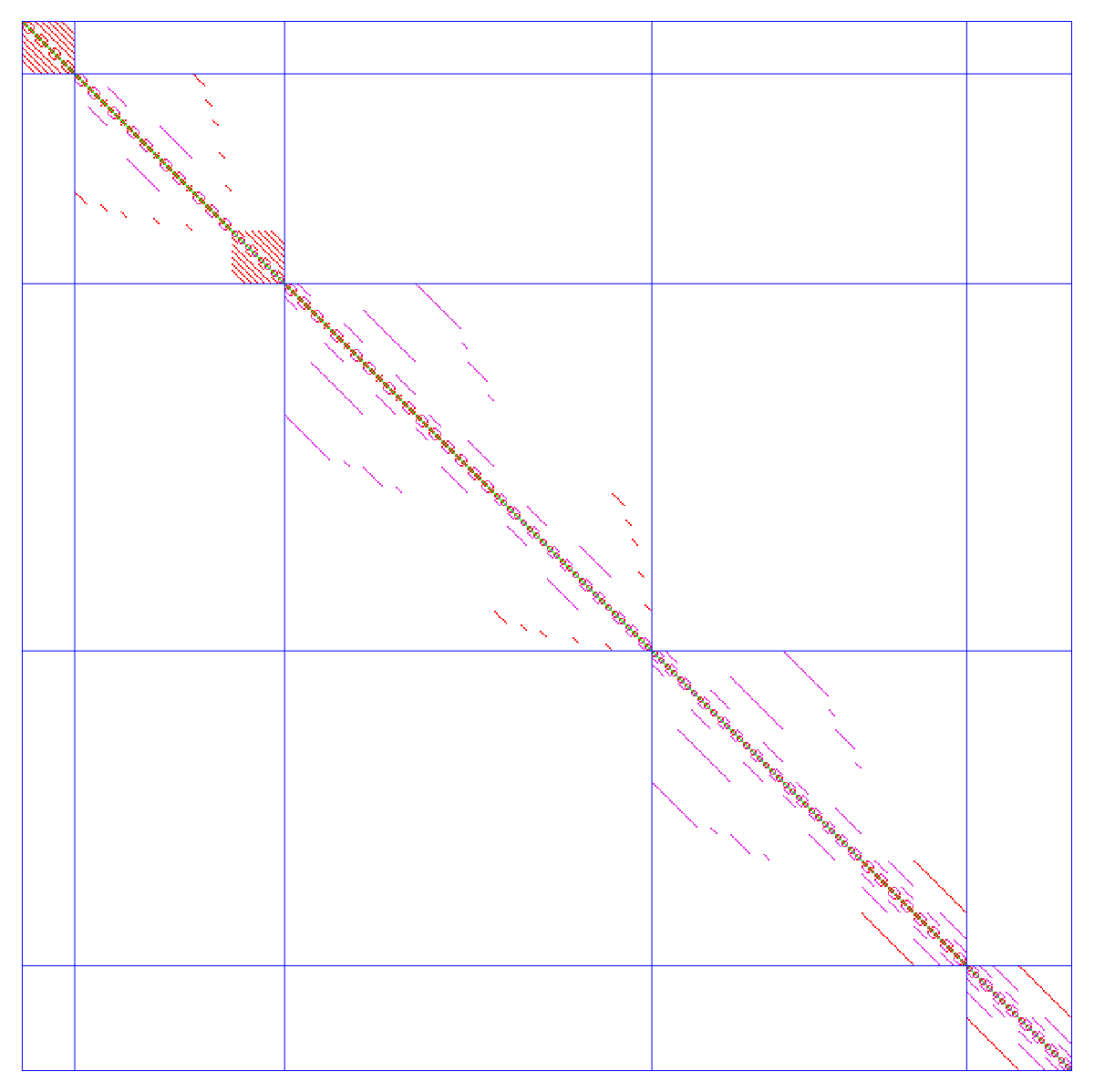 |
As the Poincare Polynomial of the 3-sphere is  , the Poincare Polynomial of the product is
, the Poincare Polynomial of the product is  by Kuenneth. Indeed, we can confirm that the kernels of the blocks of L=D2 have dimension 1,1,0,1,1.
by Kuenneth. Indeed, we can confirm that the kernels of the blocks of L=D2 have dimension 1,1,0,1,1.
| The connection Laplacian of S1 x S3 |
The connection operator of S3 x S1 |
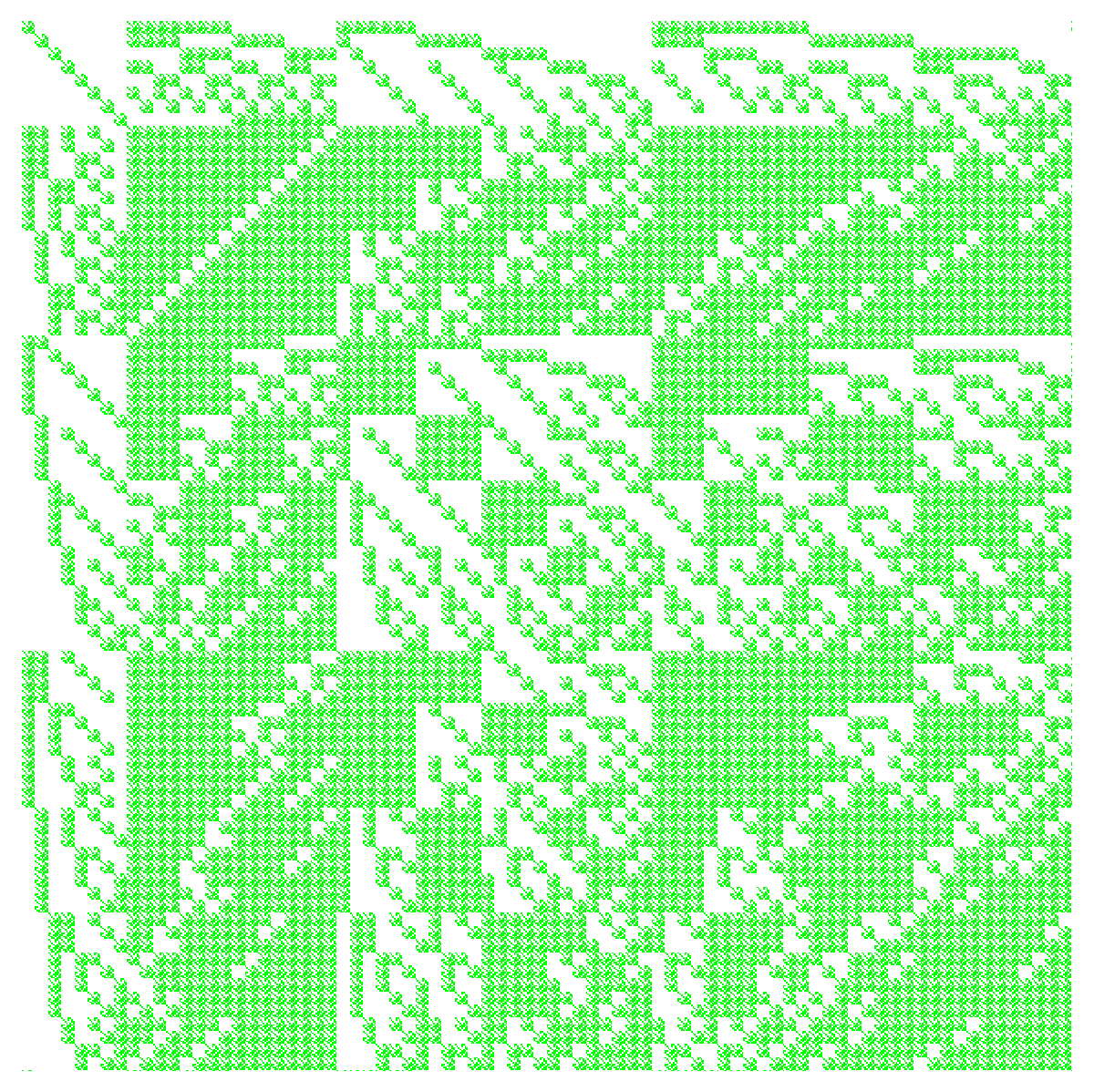
|
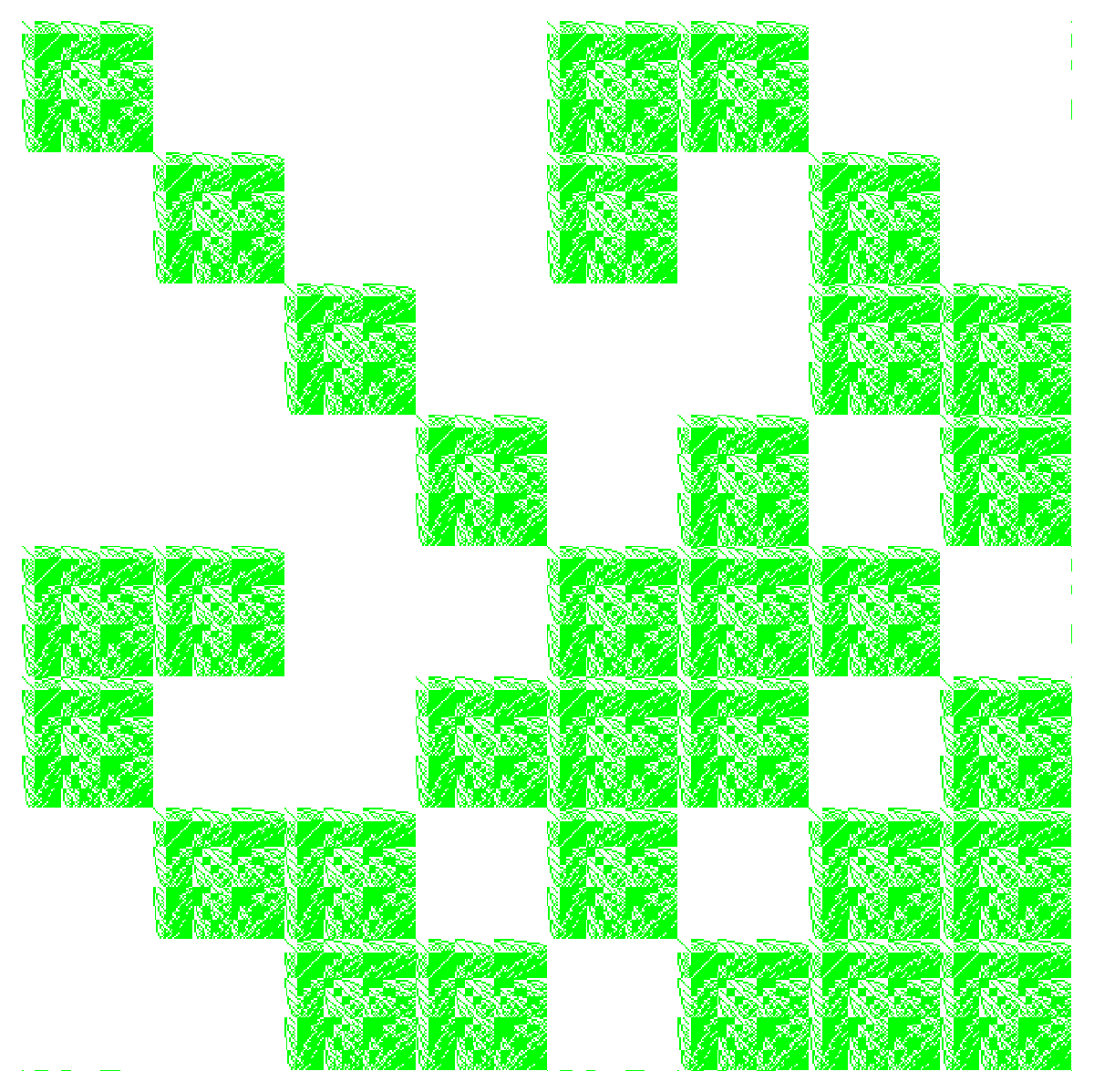
|
The 4-manifold P2 x P2
Lets look at the product of two projective planes. I don’t know what the smallest simplicial complex which implements the projective plane. I work here with one containing 15+42+28 = 85 simplices. Now the Dirac operator of the product is a  matrix with n=852 = 7225. The projective plane is interesting as it is non-orientable. The Poincare duality does not hold. The Betti vector
matrix with n=852 = 7225. The projective plane is interesting as it is non-orientable. The Poincare duality does not hold. The Betti vector  has no entry in the volume part. By the Kuenneth formula, the 4-manifold
has no entry in the volume part. By the Kuenneth formula, the 4-manifold  has the Betti vector (1,0,0,0,0). Here are pictures of the matrices:
has the Betti vector (1,0,0,0,0). Here are pictures of the matrices:
| The Dirac operator D of P2 x P2 |
The Hodge Laplacian D2 of P2 x P2 |
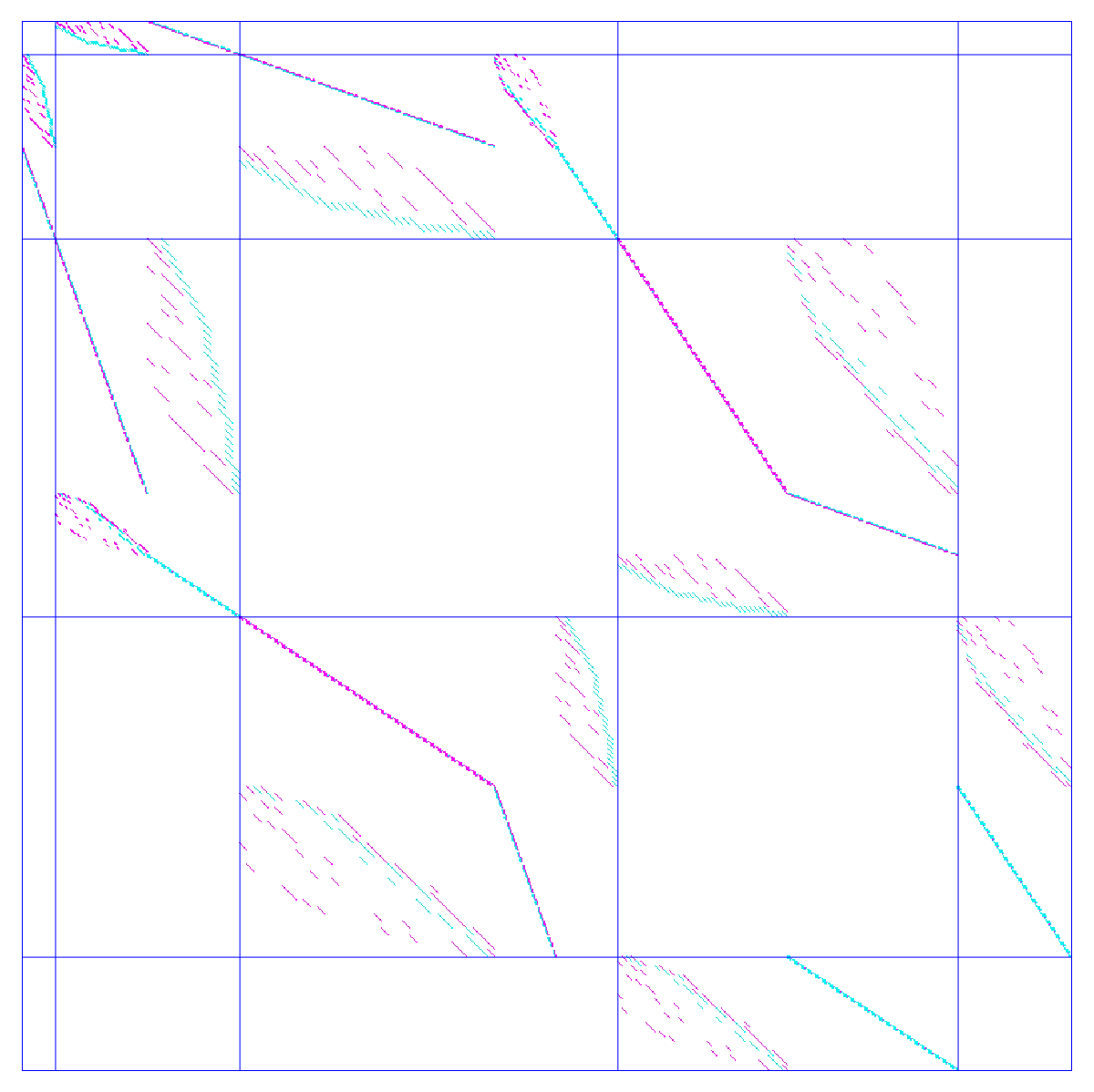
|
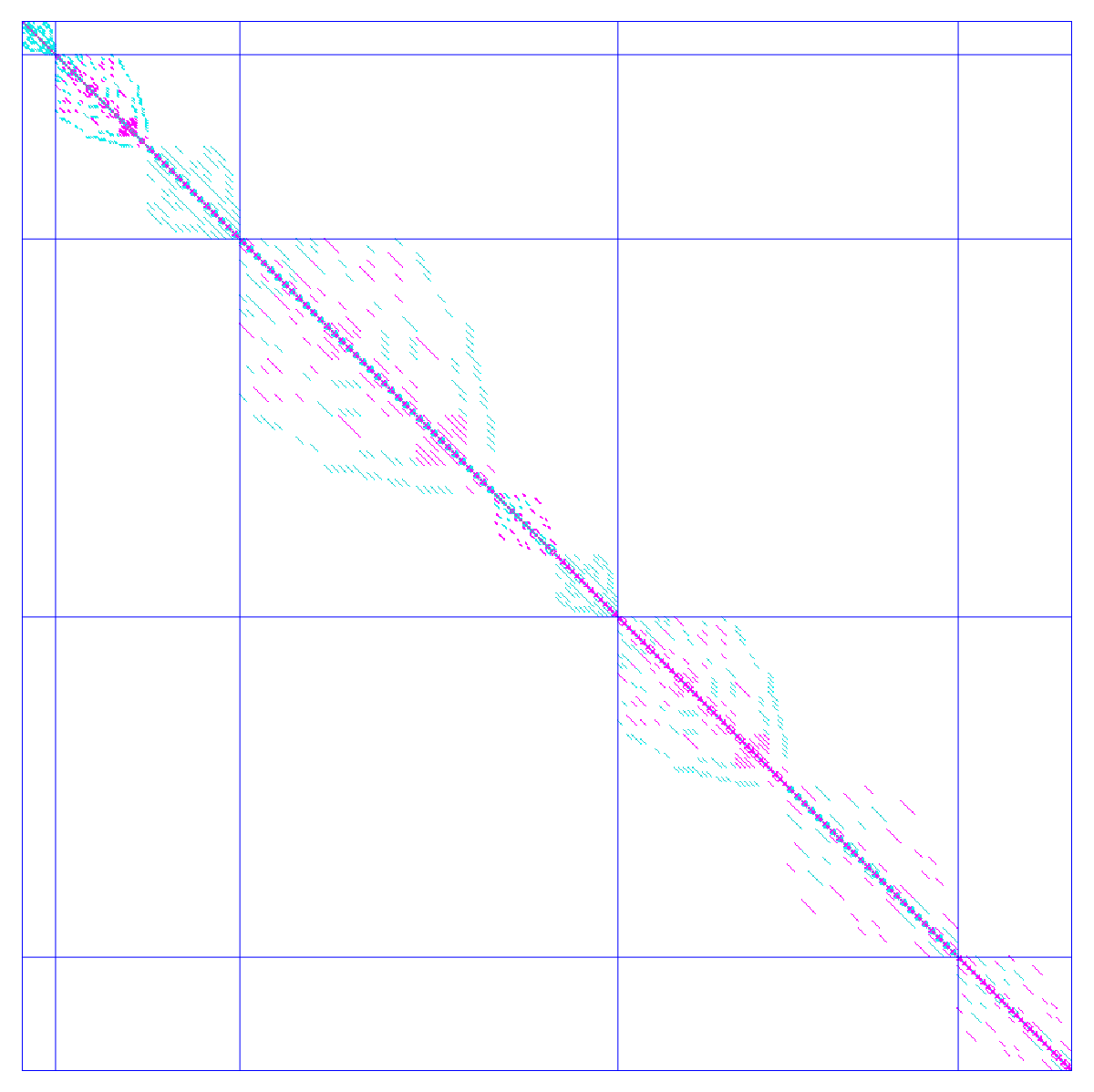 |
| The connection Laplacian of P2 x P2 |
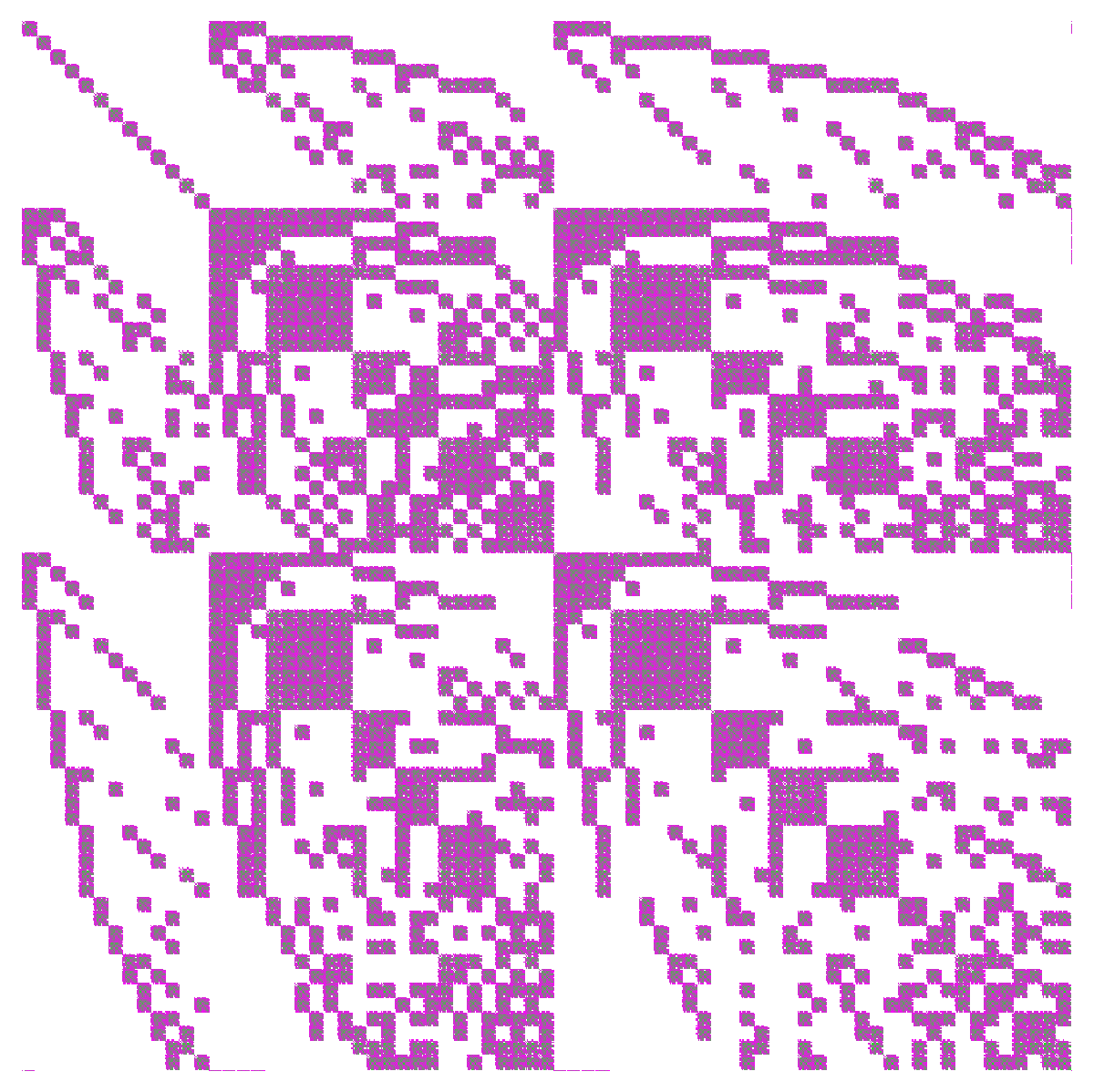
|
The 4-manifold T4
Now lets look at T4 = T2 x T2, the four dimensional torus. We take flat species of a 2-torus with f-vector (16,48,32) so that we deal with a simplicial complex containing 96 elements (flat means of course that the curvature is zero at every point. Indeed, every unit sphere in this graph has 6 elements leading to Euler curvature 0). What is the point if we could just work with the 4 torus? The point is that we don’t have ourself to build a triangulation of the 4 torus. It would be rather big. The CW complex we are dealing with has now only 9216 elements. Now this is still far off from optimal as we can in the strong ring directly look at  and work with
and work with  Diarc matrices. But as we have not yet implemented the Dirac operator for arbitrary number of factors in a product, we just do it here with T2 x Tsup>2. The Betti vector of the 4 torus is (1,4,6,5,1) which by Kuenneth can also be seen from the coefficients of
Diarc matrices. But as we have not yet implemented the Dirac operator for arbitrary number of factors in a product, we just do it here with T2 x Tsup>2. The Betti vector of the 4 torus is (1,4,6,5,1) which by Kuenneth can also be seen from the coefficients of  . Here are the
. Here are the  matrices. With the Dirac operator of the graph implementing the 4 torus (like in Kuenneth for Graphs), we would have to deal with the Whitney complex of a graph with 9216 elements. We would have to deal with Dirac operators with more than hundred of thousands rows which is hard to compute with.
matrices. With the Dirac operator of the graph implementing the 4 torus (like in Kuenneth for Graphs), we would have to deal with the Whitney complex of a graph with 9216 elements. We would have to deal with Dirac operators with more than hundred of thousands rows which is hard to compute with.
| The Dirac operator D of T4 |
The Hodge Laplacian D2 of T4 |
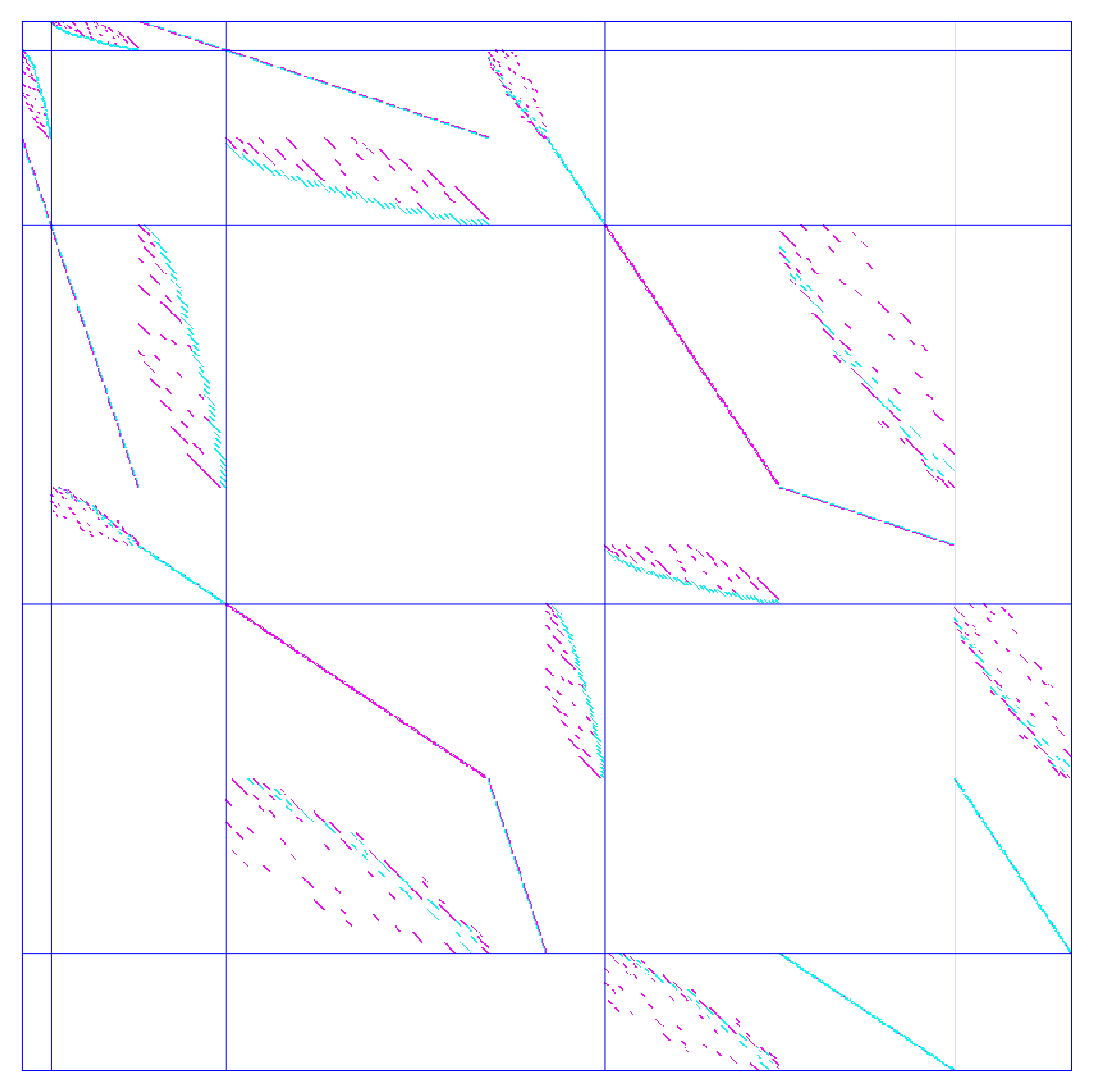
|
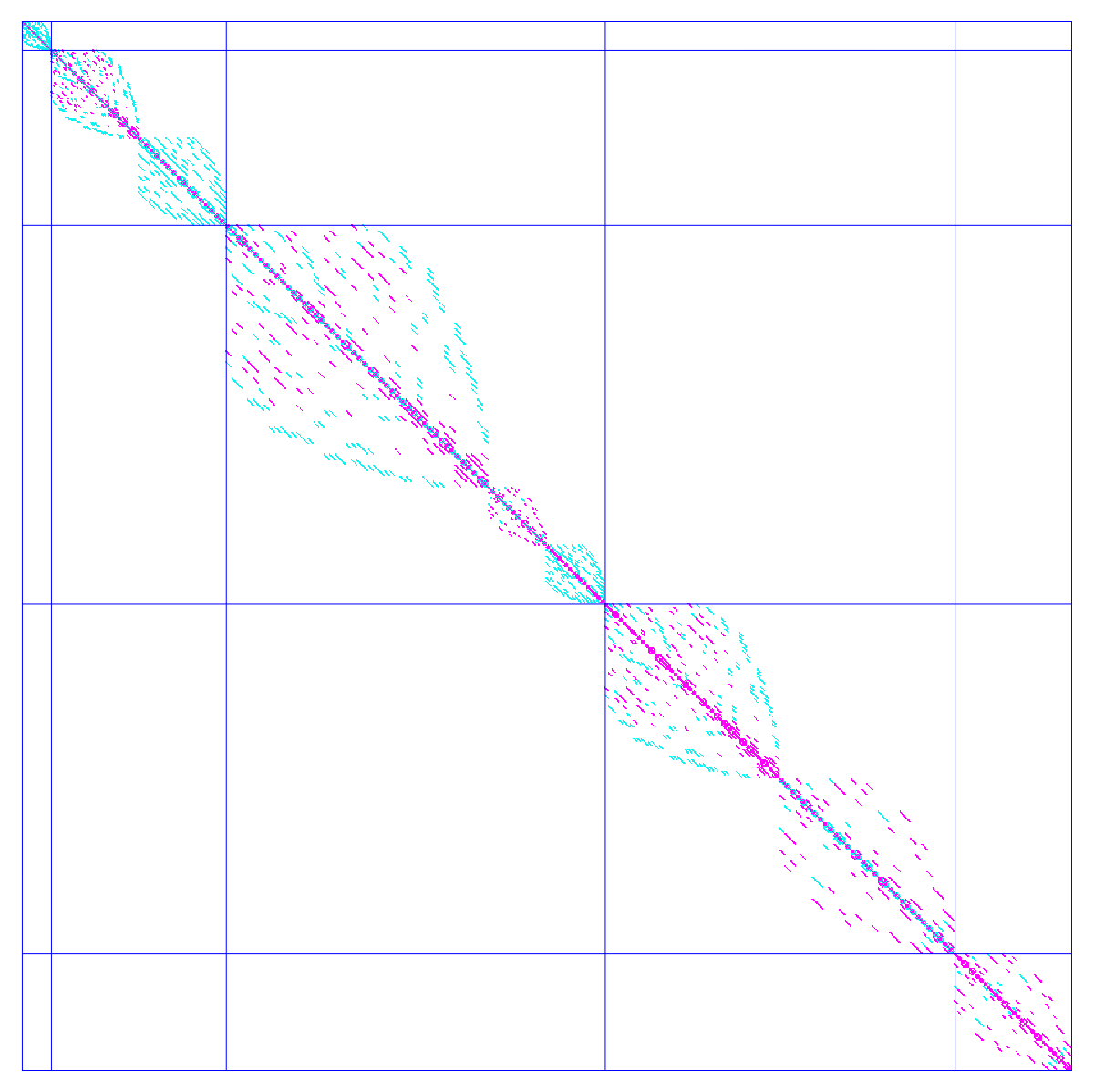 |
| The connection Laplacian of T2 x T2 |
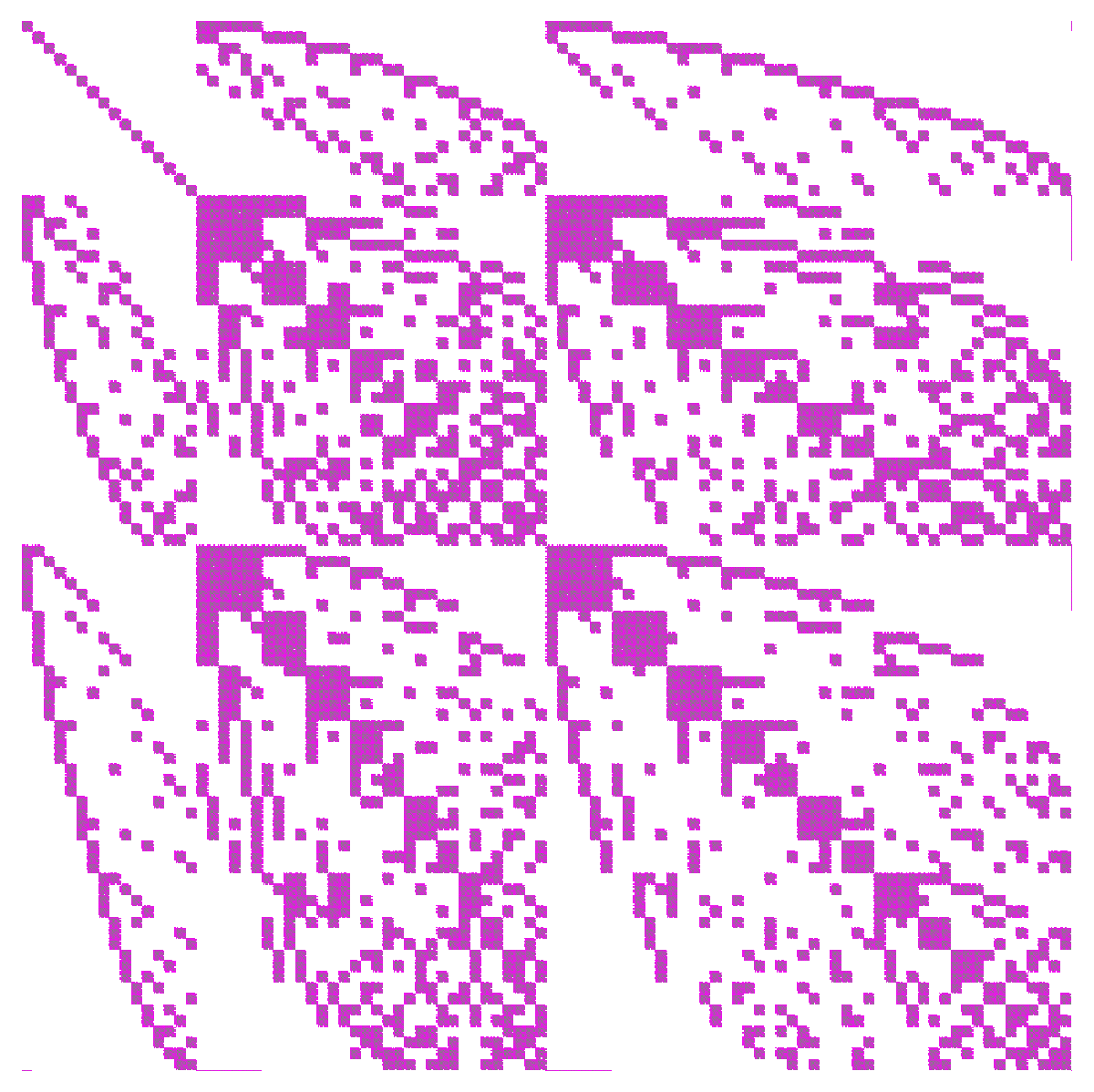
|
of simplicial complexes
without going to the Barycentric refined simplicial complex has numerical advantages. If G is a finite abstract simplicial complex with n elements and H is a finite abstract simplicial complex with m elements, then
is a strong ring element with n*m elements. Its Barycentric refinement is the Whitney complex of the graph in which two elements (a,b) and (c,d) in the product are connected if one is contained in the other. So far, when computing the cohomologies for a product, I always did it with the Barycentric refinement which is a simplicial complex but which is more costly. Working with the Dirac operator of the element G x H in the strong ring is more efficient. It does not matter that the object
was not the Whitney complex of a graph any more, and not even a simplicial complex as the product has thrown us out from the class of simplicial complexes in the larger class of CW complexes (a class no more closed under products so that we had to look at the strong ring which now does things marvelously well). As it an element in the strong ring we have a Dirac operator D on the same Hilbert space as the connection Laplacian L. By Hodge which immediatly generalizes to the strong ring, the Betti numbers are just the dimensions of the kernels of the blocks of the Hodge Laplacian H=D2. Whats the point of computing the Dirac operator of products if we can just know the cohomology for example by Kuenneth? The point is that there is much more to know about the Dirac operator. We are interested in the spectra for example. We are interested in curvatures, we are interested in the nodal regions of the eigenvalues if the complex is a discrete manifold, we are interested in the isospectral deformations by the Lax pair dynamics given naturally on such complexes. In other words, we are not only interested in properties which are homotopy invariant like cohomology or topological invariants like dimension or the structure of singularities, we are also interested in properties which are of metric nature or even differential geometric nature. An example of quantities which are not topological but depend on the metric realization of the geometric object are spectra. Others are the structure of the eigenvectors or the structure of the Euler curvature or then the dynamics of the linear and nonlinear waves on this geometric structure. Then given some functions f, one can also look at the Morse theory but that works the same as before. All basic theorems like Gauss-Bonnet, Poincaré-Hopf or Lefschetz-Brouwer go over to the strong ring. Here are a few examples:





, the Poincare Polynomial of the product is
by Kuenneth. Indeed, we can confirm that the kernels of the blocks of L=D2 have dimension 1,0,2,0,1. By the way, one can easily see algebraically that if the factors G and H satisfy Poincare duality (palindromic Betti vector), then also the product has.








, the Poincare Polynomial of the product is
by Kuenneth. Indeed, we can confirm that the kernels of the blocks of L=D2 have dimension 1,1,0,1,1.


matrix with n=852 = 7225. The projective plane is interesting as it is non-orientable. The Poincare duality does not hold. The Betti vector
has no entry in the volume part. By the Kuenneth formula, the 4-manifold
has the Betti vector (1,0,0,0,0). Here are pictures of the matrices:



and work with
Diarc matrices. But as we have not yet implemented the Dirac operator for arbitrary number of factors in a product, we just do it here with T2 x Tsup>2. The Betti vector of the 4 torus is (1,4,6,5,1) which by Kuenneth can also be seen from the coefficients of
. Here are the
matrices. With the Dirac operator of the graph implementing the 4 torus (like in Kuenneth for Graphs), we would have to deal with the Whitney complex of a graph with 9216 elements. We would have to deal with Dirac operators with more than hundred of thousands rows which is hard to compute with.




